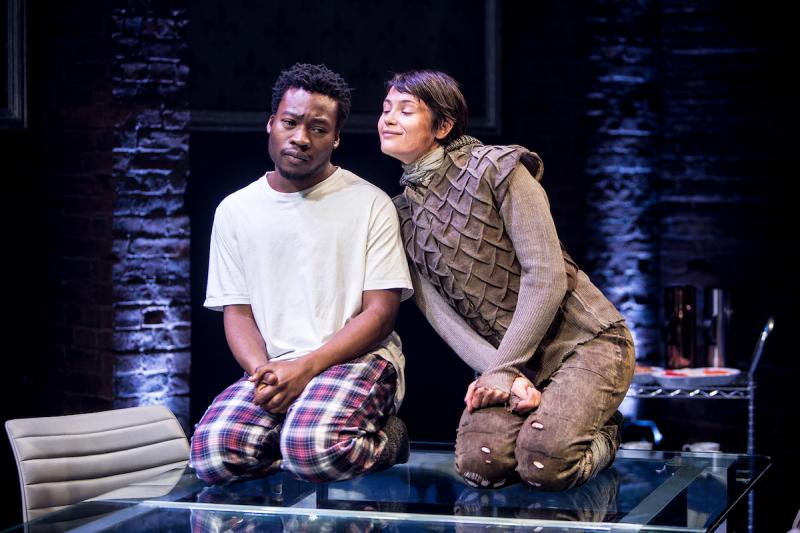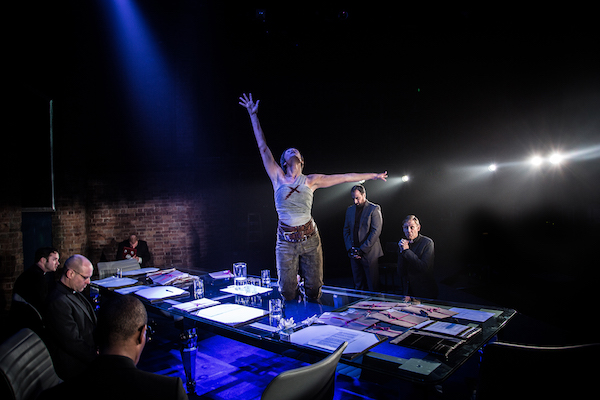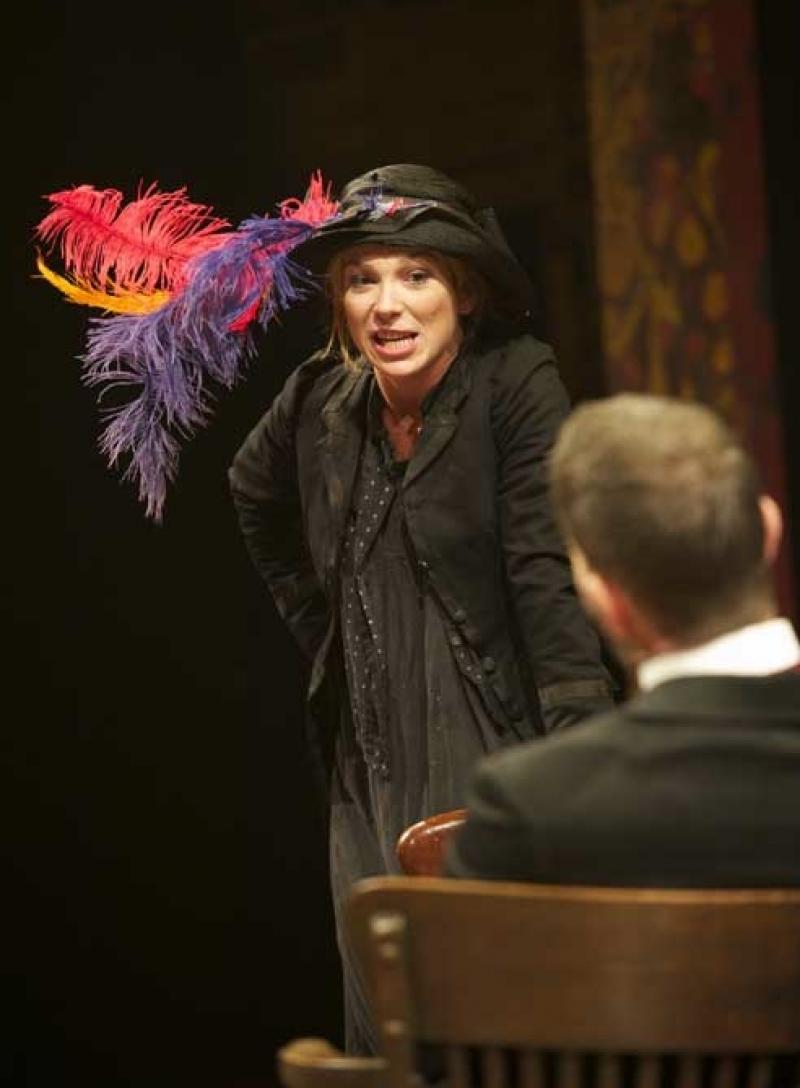Saint Joan, Donmar Warehouse | reviews, news & interviews
Saint Joan, Donmar Warehouse
Saint Joan, Donmar Warehouse
Revival of Shaw classic is a tour de force for Gemma Arterton

How’s this for a Christmas-week story? Joan, a young peasant girl – played in this version by the charismatically attractive Gemma Arterton – grows up in the bleak French countryside. She hears voices. It’s 1429, and they tell her to lift the siege of Orleans and defeat the English invaders. She inspires troops, she inspires the Dauphin. She helps crown him King of France. She is betrayed, captured by the English, tried as a heretic and burnt at the stake. Some 25 years later, the authorities realise that they have made a terrible mistake.
You can easily see why George Bernard Shaw’s play, which was first put on in 1923, soon after Joan’s canonisation as a saint, is regarded as a tragedy, albeit a tragedy without villains, since all of the main protagonists behave more or less in good faith. Its full title is Saint Joan: A Chronicle Play in Six Scenes and an Epilogue, and Shaw’s own wordy preface includes his vision of the moral of the story: “It is what men do at their best, with good intentions, and what normal men and women find that they must and will do in spite of their intentions.” Yes, there are no winners in this tale.
Joan is a member of the awkward squad, a danger to complacency
This modern-dress version of the play (pictured below), is directed by Josie Rourke and designed by Robert Jones, and starts with Duncan McLean’s video screens proclaiming the Shawism: “Must Christ perish in every age to save those that have no imagination?” and, in tribute to the anniversary of another war, showing the steady fall of red poppy petals. Then we are in the world of Bloomberg and commodities futures, as the screen reports that egg prices are soaring because of an inexplicable shortage (an in-joke about the play, which indeed starts with Joan’s miraculous ability to make hens lay eggs). The story then unfolds through a series of set-piece scenes – Joan meets the Dauphin, Joan relieves Orleans, the English plot Joan’s downfall, Joan is tried and condemned as a heretic.
 Although the play has its Shavian windbag longueurs, this production radiates with contemporary resonance. First, it is a story about an outsider who galvanises a nation, making it proud and patriotic again (echoes of Brexit), and, second, it is also a story about social justice, and individual responsibility. Joan upsets the hierarchical feudal system by insisting that she doesn’t need the church as an intermediary: God speaks to her directly. In her fanaticism, we can hear echoes of any religious fundamentalist. And her trial for heresy, during which she is also accused of witchcraft, shows how men hate women who succeed. For Joan is a member of the awkward squad, a danger to complacency and routine: one of the charges against her was her transvestitism.
Although the play has its Shavian windbag longueurs, this production radiates with contemporary resonance. First, it is a story about an outsider who galvanises a nation, making it proud and patriotic again (echoes of Brexit), and, second, it is also a story about social justice, and individual responsibility. Joan upsets the hierarchical feudal system by insisting that she doesn’t need the church as an intermediary: God speaks to her directly. In her fanaticism, we can hear echoes of any religious fundamentalist. And her trial for heresy, during which she is also accused of witchcraft, shows how men hate women who succeed. For Joan is a member of the awkward squad, a danger to complacency and routine: one of the charges against her was her transvestitism.
Inevitably Arterton has to carry the weight of all of this on her well-toned shoulders. Luckily, despite her warrior gear, this is a modern-day production so it doesn’t matter that she never looks or acts like a peasant girl. Instead, her performance has the sweet naivety of the well-brought-up young woman whose beliefs inspire her to be goodness incarnate. It’s also a very tactile reading: Joan touches the hands, the arms and the faces of her accusers in a genuinely saintly manner, glowing with forgiveness. A mixture of eloquent simplicity and ardent fanaticism, she attracts and repels in equal measure. It’s probably blasphemous to call her acting miraculous, but at some moments it really feels like that.
The rest of the cast (the men) can’t really compete with this radiance, although I liked Fisayo Akinade’s campy Dauphin, Niall Buggy’s aggressive archbishop, Hadley Fraser’s loyal Dunois and Jo Stone-Fewings’s scheming Warwick. Richard Cant, Syrus Lowe, Rory Keenan and Matt Bardock take on a couple of roles each. Amid constant video reminders of Joan’s place in the iconography of the Catholic church, and on a revolving stage, this is a very long, but intellectually fascinating and emotionally moving evening. Despite its contemporary relevance, there may not be a lot of Christmas cheer to be derived from this story, but some crumbs of cold comfort will almost certainly fall into your lap.
- Saint Joan is at the Donmar Warehouse until 18 February 2017
- Read more theatre reviews on theartsdesk
MORE GEORGE BERNARD SHAW ON THEARTSDESK
Mrs Warren's Profession, Comedy Theatre (2010). Felicity Kendal in plodding revival of Shaw's take on prostitution
 Pygmalion, Chichester Festival Theatre (2010). Rupert Everett's sulky Higgins is outsmarted by Honeysuckle Weeks's Eliza (pictured)
Pygmalion, Chichester Festival Theatre (2010). Rupert Everett's sulky Higgins is outsmarted by Honeysuckle Weeks's Eliza (pictured)
The Doctor's Dilemma, National Theatre (2012). Tragedy is the spoonful of sugar that helps this medical satire go down
Widowers' Houses, Orange Tree Theatre (2014). A timely revival of a timeless satire
Man and Superman, National Theatre (2015). A theatrical trip to Hell with Ralph Fiennes has some heavenly moments
The Philanderer, Orange Tree Theatre (2016). Modern-dress Shaw is resonant but long-winded
@AleksSierz
OVERLEAF: MORE GEMMA ARTERTON ON THEARTSDESK
How’s this for a Christmas-week story? Joan, a young peasant girl – played in this version by the charismatically attractive Gemma Arterton – grows up in the bleak French countryside. She hears voices. It’s 1429, and they tell her to lift the siege of Orleans and defeat the English invaders. She inspires troops, she inspires the Dauphin. She helps crown him King of France. She is betrayed, captured by the English, tried as a heretic and burnt at the stake. Some 25 years later, the authorities realise that they have made a terrible mistake.
You can easily see why George Bernard Shaw’s play, which was first put on in 1923, soon after Joan’s canonisation as a saint, is regarded as a tragedy, albeit a tragedy without villains, since all of the main protagonists behave more or less in good faith. Its full title is Saint Joan: A Chronicle Play in Six Scenes and an Epilogue, and Shaw’s own wordy preface includes his vision of the moral of the story: “It is what men do at their best, with good intentions, and what normal men and women find that they must and will do in spite of their intentions.” Yes, there are no winners in this tale.
Joan is a member of the awkward squad, a danger to complacency
This modern-dress version of the play (pictured below), is directed by Josie Rourke and designed by Robert Jones, and starts with Duncan McLean’s video screens proclaiming the Shawism: “Must Christ perish in every age to save those that have no imagination?” and, in tribute to the anniversary of another war, showing the steady fall of red poppy petals. Then we are in the world of Bloomberg and commodities futures, as the screen reports that egg prices are soaring because of an inexplicable shortage (an in-joke about the play, which indeed starts with Joan’s miraculous ability to make hens lay eggs). The story then unfolds through a series of set-piece scenes – Joan meets the Dauphin, Joan relieves Orleans, the English plot Joan’s downfall, Joan is tried and condemned as a heretic.
 Although the play has its Shavian windbag longueurs, this production radiates with contemporary resonance. First, it is a story about an outsider who galvanises a nation, making it proud and patriotic again (echoes of Brexit), and, second, it is also a story about social justice, and individual responsibility. Joan upsets the hierarchical feudal system by insisting that she doesn’t need the church as an intermediary: God speaks to her directly. In her fanaticism, we can hear echoes of any religious fundamentalist. And her trial for heresy, during which she is also accused of witchcraft, shows how men hate women who succeed. For Joan is a member of the awkward squad, a danger to complacency and routine: one of the charges against her was her transvestitism.
Although the play has its Shavian windbag longueurs, this production radiates with contemporary resonance. First, it is a story about an outsider who galvanises a nation, making it proud and patriotic again (echoes of Brexit), and, second, it is also a story about social justice, and individual responsibility. Joan upsets the hierarchical feudal system by insisting that she doesn’t need the church as an intermediary: God speaks to her directly. In her fanaticism, we can hear echoes of any religious fundamentalist. And her trial for heresy, during which she is also accused of witchcraft, shows how men hate women who succeed. For Joan is a member of the awkward squad, a danger to complacency and routine: one of the charges against her was her transvestitism.
Inevitably Arterton has to carry the weight of all of this on her well-toned shoulders. Luckily, despite her warrior gear, this is a modern-day production so it doesn’t matter that she never looks or acts like a peasant girl. Instead, her performance has the sweet naivety of the well-brought-up young woman whose beliefs inspire her to be goodness incarnate. It’s also a very tactile reading: Joan touches the hands, the arms and the faces of her accusers in a genuinely saintly manner, glowing with forgiveness. A mixture of eloquent simplicity and ardent fanaticism, she attracts and repels in equal measure. It’s probably blasphemous to call her acting miraculous, but at some moments it really feels like that.
The rest of the cast (the men) can’t really compete with this radiance, although I liked Fisayo Akinade’s campy Dauphin, Niall Buggy’s aggressive archbishop, Hadley Fraser’s loyal Dunois and Jo Stone-Fewings’s scheming Warwick. Richard Cant, Syrus Lowe, Rory Keenan and Matt Bardock take on a couple of roles each. Amid constant video reminders of Joan’s place in the iconography of the Catholic church, and on a revolving stage, this is a very long, but intellectually fascinating and emotionally moving evening. Despite its contemporary relevance, there may not be a lot of Christmas cheer to be derived from this story, but some crumbs of cold comfort will almost certainly fall into your lap.
- Saint Joan is at the Donmar Warehouse until 18 February 2017
- Read more theatre reviews on theartsdesk
MORE GEORGE BERNARD SHAW ON THEARTSDESK
Mrs Warren's Profession, Comedy Theatre (2010). Felicity Kendal in plodding revival of Shaw's take on prostitution
 Pygmalion, Chichester Festival Theatre (2010). Rupert Everett's sulky Higgins is outsmarted by Honeysuckle Weeks's Eliza (pictured)
Pygmalion, Chichester Festival Theatre (2010). Rupert Everett's sulky Higgins is outsmarted by Honeysuckle Weeks's Eliza (pictured)
The Doctor's Dilemma, National Theatre (2012). Tragedy is the spoonful of sugar that helps this medical satire go down
Widowers' Houses, Orange Tree Theatre (2014). A timely revival of a timeless satire
Man and Superman, National Theatre (2015). A theatrical trip to Hell with Ralph Fiennes has some heavenly moments
The Philanderer, Orange Tree Theatre (2016). Modern-dress Shaw is resonant but long-winded
@AleksSierz
OVERLEAF: MORE GEMMA ARTERTON ON THEARTSDESK
rating
Explore topics
Share this article
The future of Arts Journalism
You can stop theartsdesk.com closing!
We urgently need financing to survive. Our fundraising drive has thus far raised £49,000 but we need to reach £100,000 or we will be forced to close. Please contribute here: https://gofund.me/c3f6033d
And if you can forward this information to anyone who might assist, we’d be grateful.

Subscribe to theartsdesk.com
Thank you for continuing to read our work on theartsdesk.com. For unlimited access to every article in its entirety, including our archive of more than 15,000 pieces, we're asking for £5 per month or £40 per year. We feel it's a very good deal, and hope you do too.
To take a subscription now simply click here.
And if you're looking for that extra gift for a friend or family member, why not treat them to a theartsdesk.com gift subscription?
more Theatre
 Edinburgh Fringe 2025 reviews - Monstering the Rocketman by Henry Naylor / Alex Berr
Tabloid excess in the 1980s; gallows humour in reflections on life and death
Edinburgh Fringe 2025 reviews - Monstering the Rocketman by Henry Naylor / Alex Berr
Tabloid excess in the 1980s; gallows humour in reflections on life and death
 Edinburgh Fringe 2025 reviews: Lost Lear / Consumed
Twists in the tail bring revelations in two fine shows at the Traverse Theatre
Edinburgh Fringe 2025 reviews: Lost Lear / Consumed
Twists in the tail bring revelations in two fine shows at the Traverse Theatre
 Make It Happen, Edinburgh International Festival 2025 review - tutting at naughtiness
James Graham's dazzling comedy-drama on the rise and fall of RBS fails to snarl
Make It Happen, Edinburgh International Festival 2025 review - tutting at naughtiness
James Graham's dazzling comedy-drama on the rise and fall of RBS fails to snarl
 Edinburgh Fringe 2025 reviews: I'm Ready To Talk Now / RIFT
An intimate one-to-one encounter and an examination of brotherly love at the Traverse Theatre
Edinburgh Fringe 2025 reviews: I'm Ready To Talk Now / RIFT
An intimate one-to-one encounter and an examination of brotherly love at the Traverse Theatre
 Top Hat, Chichester Festival Theatre review - top spectacle but book tails off
Glitz and glamour in revived dance show based on Fred and Ginger's movie
Top Hat, Chichester Festival Theatre review - top spectacle but book tails off
Glitz and glamour in revived dance show based on Fred and Ginger's movie
 Edinburgh Fringe 2025 reviews: Alright Sunshine / K Mak at the Planetarium / PAINKILLERS
Three early Fringe theatre shows offer blissed-out beats, identity questions and powerful drama
Edinburgh Fringe 2025 reviews: Alright Sunshine / K Mak at the Planetarium / PAINKILLERS
Three early Fringe theatre shows offer blissed-out beats, identity questions and powerful drama
 The Daughter of Time, Charing Cross Theatre review - unfocused version of novel that cleared Richard III
The writer did impressive research but shouldn't have fleshed out Josephine Tey’s story
The Daughter of Time, Charing Cross Theatre review - unfocused version of novel that cleared Richard III
The writer did impressive research but shouldn't have fleshed out Josephine Tey’s story
 Evita, London Palladium review - even more thrilling the second time round
Andrew Lloyd Webber's best musical gets a brave, biting makeover for the modern age
Evita, London Palladium review - even more thrilling the second time round
Andrew Lloyd Webber's best musical gets a brave, biting makeover for the modern age
 Maiden Voyage, Southwark Playhouse review - new musical runs aground
Pleasant tunes well sung and a good story, but not a good show
Maiden Voyage, Southwark Playhouse review - new musical runs aground
Pleasant tunes well sung and a good story, but not a good show
 The Winter's Tale, RSC, Stratford review - problem play proves problematic
Strong women have the last laugh, but the play's bizarre structure overwhelms everything
The Winter's Tale, RSC, Stratford review - problem play proves problematic
Strong women have the last laugh, but the play's bizarre structure overwhelms everything
 Brixton Calling, Southwark Playhouse review - life-affirming entertainment, both then and now
Nostalgic, but the message is bang up to date
Brixton Calling, Southwark Playhouse review - life-affirming entertainment, both then and now
Nostalgic, but the message is bang up to date
 Inter Alia, National Theatre review - dazzling performance, questionable writing
Suzie Miller’s follow up to her massive hit 'Prima Facie' stars Rosamund Pike
Inter Alia, National Theatre review - dazzling performance, questionable writing
Suzie Miller’s follow up to her massive hit 'Prima Facie' stars Rosamund Pike

Add comment